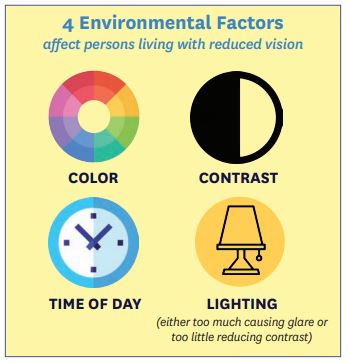Don’t Overlook Alzheimer’s’ Affect On Eyesight

In understanding the changes that occur for a person living with Alzheimer’s disease, one that may be overlooked is what may be happening to eyesight—this is distinct to the changes in vision that occur as we age. Kendra Farrow, Research and Training Associate with the National Research and Training Center (NRTC) at Mississippi State University, discussed the vision deficits in an AFA webinar, “Understanding Vision Impairments & How to Help.”
“Many individuals with Alzheimer’s disease may have a critical vision impairment where there may be nothing physically wrong with their eyes, but the brain is not fully processing visual information. The brain cannot interpret what is being seen,” said Farrow, who is herself legally blind. Here are visual impairments for caregivers to watch for:
PERIPHERAL FIELD LOSS: “Like looking through a tube,” said Farrow, individuals are unable to see things that are on the side, top or bottom, making something as simple as moving around the home without tripping or bumping into things difficult. This deficit may contribute to an inability to detect motion as well.
HOW TO HELP: Place objects directly in front of the person. Eliminate clutter from floors and tabletops.
LOSS OF CONTRAST SENSITIVITY: Individuals may experience difficulty seeing objects of the same color (e.g., an all-white bathroom or black print on a red background).
HOW TO HELP: Use high contrast colors as much as possible (e.g., place white mashed potatoes on a dark plate on a light placemat; add a colored seat cover to a white toilet; paint the wall behind a toilet a different color).
DIFFICULTY WITH DEPTH PERCEPTION: Individuals will have a harder time judging how far an object is, understanding changes in elevations, and differentiating between three dimensional objects and flat ones—so the person may feel and look off-balance. Differences between flooring (e.g., a carpet that connects to a tile floor) may be perceived as a step up or down. Individuals may try to pick up the flowers in the print of a tablecloth.
HOW TO HELP: Keep areas well lit; place brightly colored tape on the edge of stairs.
A SPECIAL NOTE ON GLARE
A saying in the field of the visually impaired is, “Contrast is our friend. Glare is our enemy,” said Farrow. She reminds caregivers to be mindful of reducing glare in a setting. Floors that are shiny may be painful to look at or perceived as wet by a person with Alzheimer’s, so consider placing a small, non-slip mat on a tile floor. Close window blinds. Consider covering mirrors in a room. A person with Alzheimer’s may perceive a person and become startled.

Adapted from an AFA Care Connection Webinar. View the recording, along with other past webinars, here. View upcoming events here.
This article originally appeared in Alzheimer’s TODAY, Volume 15, Number 4, published by AFA. View the entire issue here.


